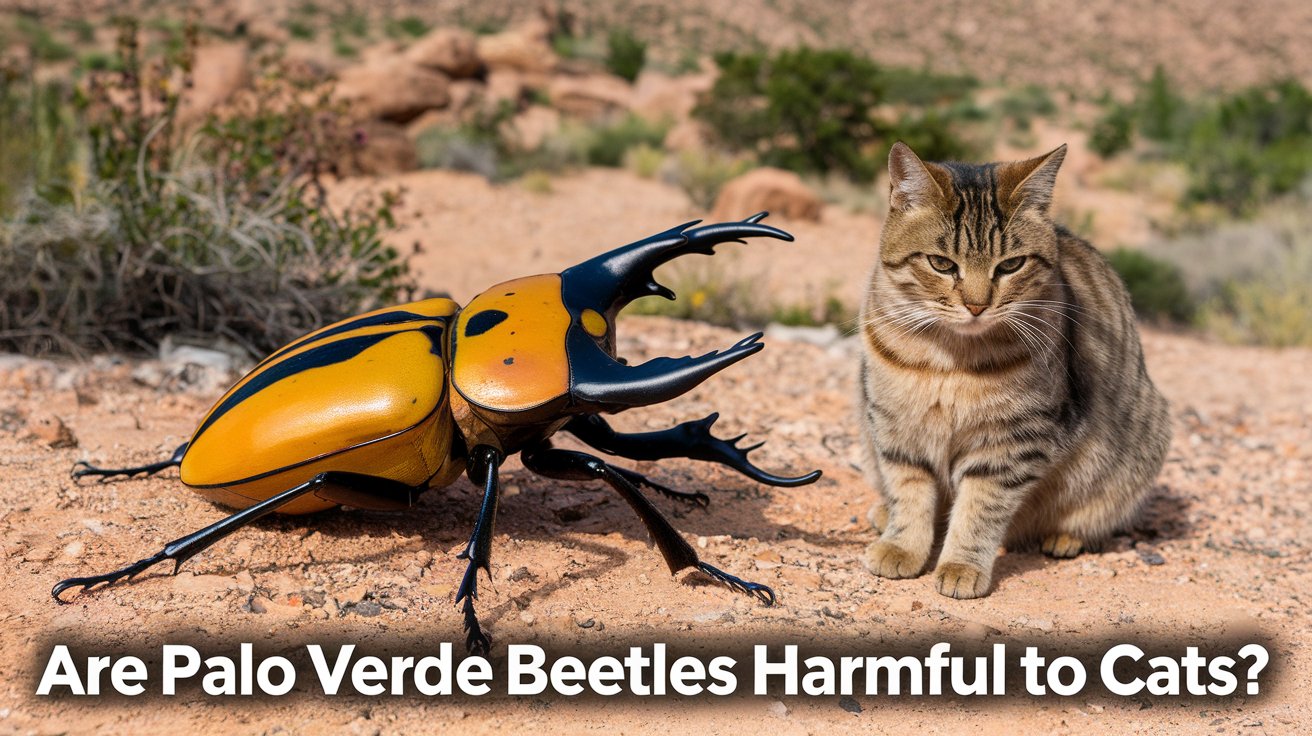
Are Palo Verde Beetles Harmful To Cats?
What Are Palo Verde Beetles?
Palo Verde beetles, scientifically known as Derobrachus geminatus, are large insects that are typically found in the southwestern regions of the U.S. They are named after the Palo Verde trees, where their larvae feed on the roots. These beetles are known for their intimidating size, often reaching up to 3 inches in length, and their hard, brown exoskeleton.
Physical Characteristics of Palo Verde Beetles
Palo Verde beetles have long antennae and strong, spiny legs. They are dark brown or black, with a hard, shiny exterior. Despite their large size, these beetles are relatively harmless to humans and animals in most cases. They have a short lifespan, with adults emerging in the summer and dying off soon after they mate and lay eggs.
Are Palo Verde Beetles Poisonous?
Let’s debunk a common myth: Palo Verde beetles are not poisonous. While their large size and appearance can be intimidating, these beetles do not carry venom and are not toxic to humans or animals, including cats. However, their strong jaws are capable of delivering a painful bite if provoked, though they rarely bite unless they feel threatened.
Can Palo Verde Beetles Harm Cats?
While Palo Verde beetles are not poisonous, they can still pose a minor risk to curious cats. Cats are natural hunters, and their instinct to chase and play with insects can lead them to interact with these beetles. If your cat catches one, it might try to eat it. In most cases, the beetle will pass through the cat’s system without any major issues, but there are a few potential concerns.

How Do Cats Typically React to Palo Verde Beetles?
Cats are naturally intrigued by small, moving creatures, so it’s not uncommon for a cat to pounce on a Palo Verde beetle. If a cat catches the beetle, it may try to play with it or even eat it. The strong exoskeleton of the beetle can be hard for cats to chew, and the beetle’s legs can be quite sharp, irritating the cat’s mouth or throat.
Are Palo Verde Beetles a Risk for Cat Health?
While Palo Verde beetles are not toxic, they could cause some mild physical discomfort for your cat. If a cat eats a beetle, there is a small chance of choking or digestive upset due to the beetle’s hard exterior. Additionally, some cats might experience mild allergic reactions after ingesting or touching the beetle. It’s always a good idea to monitor your cat after any insect encounter to ensure they’re not exhibiting signs of distress.
What Should You Do If Your Cat Eats a Palo Verde Beetle?
If your cat happens to eat a Palo Verde beetle, there’s generally no need to panic. In most cases, the beetle will be harmlessly digested. However, watch for any signs of discomfort, such as vomiting, excessive drooling, or difficulty breathing, which could indicate an allergic reaction or a blockage in the throat.
Preventing Your Cat from Interacting with Palo Verde Beetles
To minimize the risk of your cat interacting with a Palo Verde beetle, try to keep your cat indoors during the summer months when these beetles are most active. If your cat enjoys spending time outside, supervise them in your yard, especially during the evening hours when beetles are more likely to be out and about.
Can Palo Verde Beetles Infest Your Home?
While it’s unlikely, Palo Verde beetles can find their way indoors, especially if you have open windows or doors. To prevent beetles from entering your home, ensure that all windows and doors are properly sealed and consider using screens.

How to Manage Palo Verde Beetles in Your Yard
To reduce the presence of Palo Verde beetles in your yard, focus on removing their food source. Since their larvae feed on the roots of trees like the Palo Verde, keeping your yard free from dead or decaying wood can help minimize their population. Additionally, you can use non-toxic insect repellents that are safe for pets to control beetles in your outdoor spaces.
Are There Long-Term Effects If a Cat Encounters Palo Verde Beetles?
In most cases, there are no long-term effects if a cat encounters or eats a Palo Verde beetle. However, if your cat shows ongoing signs of discomfort after interacting with the beetle, it’s always wise to seek veterinary advice to rule out any underlying issues.
Do Other Pets Face the Same Risks from Palo Verde Beetles?
While cats are the most likely to interact with Palo Verde beetles due to their curious nature, other pets such as dogs may also show interest. Smaller animals like guinea pigs or hamsters could be at a greater risk of choking if they encounter a beetle, so it’s important to keep all pets away from these insects.
What Do Experts Say About Cats and Palo Verde Beetles?
Most veterinarians agree that while Palo Verde beetles aren’t a significant threat to pets, it’s still important to monitor your cat’s behavior after an encounter. Experts recommend limiting your cat’s exposure to insects in general to prevent any potential health risks.

Conclusion: Are Palo Verde Beetles Harmful To Cats?
In summary, Palo Verde beetles are not harmful to cats in the sense of being toxic or venomous. However, they can still cause minor issues such as choking, digestive discomfort, or allergic reactions. As a responsible pet owner, it’s always best to keep an eye on your cat and limit their interactions with these beetles. If your cat does eat one, monitor them for any signs of distress and contact your vet if necessary.
Frequently Asked Questions
Are beetles bad for cats?
Most beetles, including Palo Verde beetles, are not harmful to cats. They are not toxic or venomous, but if a cat eats one, it might experience mild digestive discomfort or irritation.
What if my dog ate a Palo Verde beetle?
If your dog eats a Palo Verde beetle, it is usually not a serious issue. Monitor your dog for any signs of digestive upset or discomfort, and consult a vet if any unusual symptoms occur.
How to get rid of Palo Verde beetles in Arizona?
To get rid of Palo Verde beetles in Arizona, remove potential food sources like dead wood, and use non-toxic insect repellents. Keeping your yard clean and well-maintained can also help reduce their presence.
What is the big flying beetle in Arizona?
The big flying beetle commonly found in Arizona is the Palo Verde beetle. It is known for its large size and can often be seen around Palo Verde trees.
Do drone beetles bite?
Drone beetles are generally not known to bite. They are more likely to be a nuisance due to their size and presence rather than posing a direct threat to humans or pets.

I am a dedicated writer and expert in cats, with years of experience studying feline behavior, health, and breeds. Passionate about sharing my knowledge, I provide valuable insights and practical advice to help cat lovers understand and care for their furry companions. When not writing, I enjoy spending time with my beloved cats, continually learning and deepening my expertise.

Leave a Reply